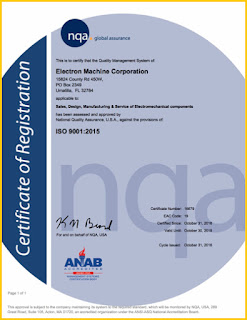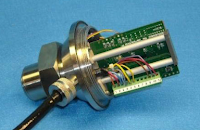This blog focuses on industrial, inline process refractometers and their use in industrial applications. Refractometry is used to measure the refractive index of a substance in order to determine its composition or purity. Posts include information on theory, construction, installation, new products and new markets.
Electron Machine Corporation | Umatilla, FL | PHONE: 352-669-3101 | ElectronMachine.com
Season's Greetings from Electron Machine
MPR- E-Scan Inline Refractometer Settings and Readings Overview
The MPR E-Scan is an in-line process refractometer that directly measures the refractive index of process fluids and then displays the reading in any number of customer-desired units (Brix, Percent Solids, Dissolved Solids, SGU, R.I., etc.). A simple 0-10Vdc signal is used to transmit the reading from the sensing head to the electronics console, ensuring a robust reading that has a minimal chance of being effected by interference. The entire package is NEMA 4X rated and designed and manufactured with the best materials for each application to provide years of trouble-free service with a minimum amount of maintenance.
The video below provides and overview of zeroing, setting, and reading the refractometer.
The video below provides and overview of zeroing, setting, and reading the refractometer.
Electron Machine Achieves ISO 9001:2015
The ISO 9001:2015 approval of a quality management system (QMS) means an organization demonstrates its ability to consistently provide products and services that meet customer and regulatory requirements, and aims to improve customer satisfaction through the effective application of the quality system, including processes for system improvement, and the assurance of conformity to customer requirements.
ISO (the International Organization for Standardization) is a worldwide federation of national standards bodies whose technical committees prepare and carry out the International Standards. ISO 9001 is the international standard that specifies requirements for the organization's quality management system. ISO 9001 was first published in 1987. The current version, ISO 9001:2015, was released in September 2015. The previous version was ISO 9001:2008.
Organizations that are certified to ISO 9001:2008 should transition up to ISO 9001:2015 as quickly as reasonably possible, but the ISO Committee on Conformity Assessment has agreed to a three year transition period.
Electron Machine Corporation achieved ISO 9001:2015 as of November 2016.
ISO (the International Organization for Standardization) is a worldwide federation of national standards bodies whose technical committees prepare and carry out the International Standards. ISO 9001 is the international standard that specifies requirements for the organization's quality management system. ISO 9001 was first published in 1987. The current version, ISO 9001:2015, was released in September 2015. The previous version was ISO 9001:2008.
Organizations that are certified to ISO 9001:2008 should transition up to ISO 9001:2015 as quickly as reasonably possible, but the ISO Committee on Conformity Assessment has agreed to a three year transition period.
Electron Machine Corporation achieved ISO 9001:2015 as of November 2016.
Replace the Sensing Head on MPR E-Scan and MDS-Divert Systems
The MPR E-Scan is a rugged, industrialized, in-line process refractometer. It directly measures the refractive index of process fluids and then displays the reading in any number of customer-desired units (Brix, Percent Solids, Dissolved Solids, SGU, R.I., etc.).
The MDS Monitor Divert System is a BLRBAC compliant Black Liquor solids monitoring system designed specifically for Black Liquor recovery boilers.
The following paper illustrates the correct way to replace the sensing head on MPR E-Scan and MDS-Divert Systems from Electron Machine Corporation.
The MDS Monitor Divert System is a BLRBAC compliant Black Liquor solids monitoring system designed specifically for Black Liquor recovery boilers.
The following paper illustrates the correct way to replace the sensing head on MPR E-Scan and MDS-Divert Systems from Electron Machine Corporation.
Inline Refractometers Tough Enough for Paper Plant Black and Green Liquor Lines
 |
| Refractometer and HPC Adapter with High Pressure Purge System |
It's said the only thing a pulp and paper plant doesn't reuse is the "shade the building casts". The processes used in the production of pulp and paper are very efficient when you consider the reuse of energy and by-products. The efficiency comes at a cost though - through very hostile atmospheres and demanding operating conditions for process equipment.
For example, the "kraft process" (also known as the sulfate process) is the method to convert wood chips into pulp and then to cellulose fibers. This is done by mixing the wood chips with sodium hydroxide and sodium sulphate, soaking, cooking and processing.
Here's a very basic explanation of the kraft process. Wood chips are soaked and processed in sodium hydroxide and sodium sulphate mixture known as "white liquor". After the wood chips are impregnated with white liquor, they are then cooked in digesters to break the wood down into cellulose. The solid pulp is then separated and the remaining fluid is referred to as "black liquor". Black liquor is further processed to remove solids and chemicals which are to be re-used in the pulping process. One of the final by-products is "green liquor" which contains sodium carbonate and sodium sulfide and is then reacted with lime to regenerate more white liquor.
All of these steps expose instruments, process equipment, piping, and valves to very tough environments. Electron Machine Corporation, a manufacturer of extremely rugged inline process refractometers, has been actively refining the use of refractometers for measuring green and black liquor density for over 30 years.
The scaling associated with these applications results in an optical coating on the refractometer sensing head. If this scaling can be controlled to allow an acceptable duration of on-line measurement, and then effectively removed when coating occurs, the accuracy of the refractometer can be fully utilized with minimal maintenance. The primary issue then becomes the maintenance required to keep the cleaning system operating effectively.
Electron Machine's efforts led to a system using their "almost indestructible" MPR E-Scan Refractometer combined with heated high-pressure water for cleaning. The resulting combination provides an effective removal of optical coatings by reducing thermal changes and minimizing maintenance to allow for a reliable measurement source for on-line automatic control.
If you're interested in refractometry in pulp and paper processing, look no further than Electron Machine. They have the history, the experience, and the toughest inline refractometer on the planet.
For more information, visit http://www.electronmachine.com or call (352) 669-3101.
Inline Refractometers for Measuring Black Liquor Evaporation
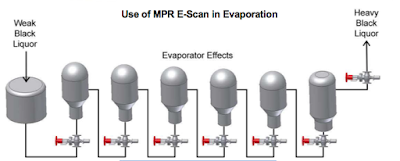 |
| Measuirng black liquor solids concentration. |
Introduction:
Refractometers have long proven to be the instrument of choice for black liquor solids concentration. Electron Machine Corporation of Umatilla, Florida pioneered this technology to accurately measure black liquor dissolved solids 5 decades ago. Their MPR E-Scan inline refractometer provides digital accuracy with rugged components required for years of reliable use when installed in harsh industrial environments. This combination allows for easy integration into a mill-wide monitor / control system providing operators the information needed for efficient and easy-to-service control.
Application:
An important and overlooked area for refractometers is the pulp washing operation. By monitoring the concentration output the washers can be balanced to meet the needs of the evaporation process and a mill is able to regulate the mixing liquor. This control allows a consistent concentration supply to the evaporators and boiler. This installation is simple and greatly reduces hand sampling.
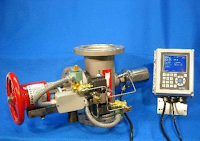 |
| MPR E-Scan |
Evaporation:
By installing the Electron Machine Corporation MPR E-Scan with Isolation Valve Adapters before and after each evaporator effect, the concentration and temperature output can be utilized to monitor efficiency, detect problems and operate economically. This monitoring allows control operators to adjust steam usage for optimal solids evaporation. Operators can determine if a quick flush cleaning can be performed to improve efficiency, prolonging the time between invasive, labor intensive cleanings. It also allows the detection of any problems before the liquor reaches the boiler, plus provides a consistent solids percentage for firing.
Conclusion:
With the addition of the Electron Machine Corporation MPR E-Scan to a mills process control system, a company can see increased profitability through the optimized control of steam usage, reduced labor cost from the reduction of offline hand sampling and the ability to prolong the time between labor intensive offline cleanings. This greater control provides more consistent firing solids allowing boilers to operator more efficiently.
Key Benefits:
By installing the Electron Machine Corporation MPR E-Scan with Isolation Valve Adapters before and after each evaporator effect, the concentration and temperature output can be utilized to monitor efficiency, detect problems and operate economically. This monitoring allows control operators to adjust steam usage for optimal solids evaporation. Operators can determine if a quick flush cleaning can be performed to improve efficiency, prolonging the time between invasive, labor intensive cleanings. It also allows the detection of any problems before the liquor reaches the boiler, plus provides a consistent solids percentage for firing.
Conclusion:
With the addition of the Electron Machine Corporation MPR E-Scan to a mills process control system, a company can see increased profitability through the optimized control of steam usage, reduced labor cost from the reduction of offline hand sampling and the ability to prolong the time between labor intensive offline cleanings. This greater control provides more consistent firing solids allowing boilers to operator more efficiently.
Key Benefits:
- Consistent black liquor solids
- Minimize steam consumption
- Economical operation
- Optimize man hours
- Reduce costly evaporator cleanings
Consistent Ice Cream Quality with Inline Process Refractometer
 |
| Inline refractometer helps make better ice cream. |
The Electron Machine MPR E-Scan refractometer is used to measure both the dairy concentration as well as the sweetener (sucrose, fructose, etc.) Brix level going into the mixing tank. This in-line measurement allows real-time trimming of both ingredients to meet the final target concentration in the mixing tank. Additional measurement of the mixed product is used for further adjustments to the composition before packaging.
By installing the Electron Machine Corporation MPR E-Scan a factory can insure an accurate process control resulting in consistent ice cream quality. Thus, increasing profit from economical operation. By maintaining a desired process concentration there will be a decrease in offline testing and an increase quality control. This results in the ability to optimize work force man hours and eliminate unnecessary product waste saving the factory time and money.
Electron Machine Maintains "A" Rating with ISNetworld
 |
| Electron Machine Maintains ISNetworld A Rating |
ISNetwork’s goal is to connect hiring clients with safe, reliable and sustainable contractors and suppliers. Their process (for contractors) requires maintaining accurate information, records, and processes concerning insurability, safety, training, hiring, and diversity information. ISNetwork's hiring clients and contractors both benefit through a streamlined, thorough, and consistent qualification process.
Electron Machine Corporation is proud to be an ISNetwork approved contractor in good standing and has has been awarded an “A” in contractor rating for demonstrating high standards of quality and safety. An “A” rating typically means the contractor is listed as “excellent/preferred” and can be hired without restriction.
Reliably and Consistently Measuring Green Liquor Density in the Paper Mill
| Paper mill green liquor density measurement system. |
The difficult scaling associated with green liquor results in an optical coating on the refractometer sensing head. If this scaling can be controlled to allow an acceptable duration of on-line measurement, and then effectively removed when coating occurs, the accuracy of the refractometer can be fully utilized with minimal maintenance. The primary issue then becomes the maintenance required to keep the cleaning system operating effectively.
Using inline refractometers with accompanying heated high-pressure water cleaning systems provides excellent results in effective removal of optical coatings by reducing thermal changes, minimizing maintenance, and allowing for a reliable measurement source for on-line automatic control.
The Electron Machine MPR EScan is used to measure the green liquor dissolved density, or TTA, at two stages in the process: after the green liquor dissolving tank and after the green liquor clarifier. The in-line measurement, with the refractometer sensing head installed directly in the main process lines, allows real-time control of green liquor dilution to meet target TTA set-points. The measurement is also used to indicate (and prevent) excessive green liquor density and the resulting dangerous impending crystallization within the dissolving tank.
| Electron Machine MPR Escan |
Reducing the variation of green liquor solids by automatically controlling weak-wash dilution with the MPR E-Scan refractometer results in a reduction in scaling. Scaling issues are further reduced when pressurized water, heated to the process temperature, is used to effectively clean the refractometer optical components. The compound result is beneficial for both control and maintenance.
For more information, visit www.electronmachine.com or call 352-669-3101.
Benchtop Refractometer Rugged Enough For Field Use
 |
| DSA E-Scan Dissolved Solids Analyzer |
The refractive index of a substance is dependent, in part, upon temperature and the wavelength of light used in the measurement. Common applications include Brix testing for sucrose level, along with others in the beverage, pulp and paper, chemical, flavor, and fragrance industries. Refractometry is used as a quality control measurement, to assure uniformity among product batches.
Manual refractometers have been available for many years and require human observation and interpretation of a scale reading to obtain a refractive index. Automatic, as well as in-line units are available today that provide uniform accuracy and faster sample processing.
The DSA E-Scan, manufactured by Electron Machine, is an automatic, bench-top critical angle refractometer with a digital readout and temperature-controlled sample chamber. Its compact size and rugged design permit operation in the field and in areas with limited space. The unit provides fast and accurate refractive index measurements of sample liquids.
Refractometer for Juice Concentration Processing
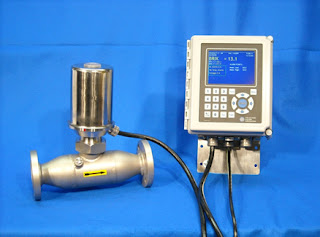 |
| In-line process refractometer |
The array of fruits processed into concentrate includes almost every commercially harvested type.
Juice is extracted from various fruits in a number of ways that are specifically adapted for the shape, size, and nature of the fruit. Once the juice is extracted and purified it will generally be stored in a primary tank which serves as the feed device to the evaporator. Juice concentration will vary at this initial stage due to a number of natural factors. The concentration process output will provide product uniformity.
Regardless of the method used for concentrating the juice, in-line process refractometers can be used at strategic points in the process to measure solids concentration and evaluate equipment performance and product quality. Output signals from the refractometers serve as inputs to the command and control system for the evaporators, allowing feed rate to closely match evaporation rate and make most efficient use of the energy consuming equipment.
Regardless of the method used for concentrating the juice, in-line process refractometers can be used at strategic points in the process to measure solids concentration and evaluate equipment performance and product quality. Output signals from the refractometers serve as inputs to the command and control system for the evaporators, allowing feed rate to closely match evaporation rate and make most efficient use of the energy consuming equipment.
In an industrial environment, ruggedness, reliability, and accuracy are key features needed for an in-line process refractometer. Share your refractometry challenges with the experts at Electron Machine Corporation and get effective solutions.
Applying Process Refractometers in Sugar Cane Processing
 |
| Raw and final product of sugar refining |
To achieve high quality liquid and crystal sugars and contain production cost, refractometers are employed to deliver accurate in-line Brix and other measurements in the cane sugar refining and milling processes.
Specific uses of refractometers in sugar production are:
- Product flow adaptation to evaporator capacity to achieve energy savings.
- Extraction process optimization, minimizing the use of water that will need to be removed at the evaporator.
- Separation column feed juice control to adjust concentration to match capacity.
- Quality assurance check on liquid bulk sugar and molasses.
- Vacuum pan automatic and accurate seeding.
- Monitor supersaturation over complete strike of crystallization.
Share your refractometry challenges and applications with the experts at Electron Machine Corporation for effective solutions.
Welcome to the Refractometers for Industry Blog
We're glad you found us and hope you visit back often. This blog will provide weekly posts on the science of refractometry and its use in industrial application. Topics will cover design, construction, uses, new products and new markets for industrial refractometers.
So, sign up for our email alerts (above) and stay tuned for more information!
So, sign up for our email alerts (above) and stay tuned for more information!
Subscribe to:
Posts (Atom)

